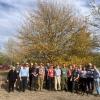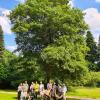Editor's Picks
Plant Focus
To create an account click here; if you have already registered, click here to become a member.
Individual articles can be purchased for U$S 10. If you would like to purchase an article, email a request to website@internationaloaksociety.org
Published May 2024 in International Oaks No. 35: 25–36
Abstract
Conservation assessments are typically conducted at the species level, with each species evaluated separately. This approach overlooks the potential role of interspecific gene flow, primarily introgressive hybridization (IH), in shaping species diversity and adaptation, particularly at the syngameon level. The genus Quercus, with the well-known interfertility of the species that compose it, offers an ideal case study for examining the impact of IH.
Here, I present a novel method developed with colleagues to quantify the potential for IH across all 84 oak species within the contiguous United States. Our technique uses geospatial data to assess sympatry (i.e., the overlap in geographic distribution among each species pairs), considered as a proxy for IH potential. Notably, only 12.6% of US counties harbor just one oak species, indicating that oak species are typically sympatric with other oak species. For instance, section Lobatae oaks (Red Oaks) typically coexist with 5.7 (up to 15) other Red Oak species, and section Quercus oaks (White Oaks) with 3.8 (up to 13) other White Oak species in a single county. By compiling sympatry through pairwise metrics, we explore the network properties of each sectional syngameon within the oak genus
This sheds light on potential gene flow within each section between interfertile species in sections Lobatae and Quercus. Some species share habitat with over approximately 20 other interfertile species across their range. Our findings underline the importance of considering species interactions and potential gene flow in conservation efforts. We argue that conservation strategies must evolve beyond the species level to incorporate these broader ecological and evolutionary dynamics.
Keywords
introgression, introgressive hybridization, interspecific gene flow, conservation management
References
Anderson, E. 1949. Introgressive Hybridization. New York: John Wiley & Sons.
Arnold, M.L. 2015. Divergence with Genetic Exchange. Oxford: Oxford University Press.
Cannon, C.H., J. Kartesz, S. Hoban, M.I. Loza, E. Beckman-Bruns, and A.L. Hipp. n.d. Quantifying exposure to introgressive hybridization among oak species in the contiguous US and its implications for biodiversity conservation. Plants, People, Planet.
Cannon, C.H., and R.J. Petit. 2020. The oak syngameon: more than the sum of its parts. New Phytologist 226(4): 978-983.
Cannon, C.H., and C.L. Scher. 2017. Exploring the potential of gametic reconstruction of parental genotypes by F1 hybrids as a bridge for rapid introgression. Genome 60(9): 713-719.
Denk, T., G.W. Grimm, P.S. Manos, M. Deng, and A.L. Hipp. 2017. An Updated Infrageneric Classification of the Oaks: Review of Previous Taxonomic Schemes and Synthesis of Evolutionary Patterns. In Oak Physiological Ecology. Exploring the Functional Diversity of the genus Quercus L. Edited by E. Gil-Pelegrín, J.J. Peguero-Pina, and D. Sancho-Knapik. Cham: Springer International Publishing, AG.
Kartesz, J.T. 2022. The Biota of North America Program (BONAP). North American Plant Atlas. http://bonap.net/napa
Mayr, E. 1942. Systematics and the Origin of Species from the Viewpoint of a Zoologist. New York: Columbia University Press. Suárez-González, A., C. Lexer, and Q.C.B. Cronk. 2018. Adaptive introgression: a plant perspective. Biology Letters 14(3). https://doi.org/10.1098/rsbl.2017.0688
Wilkins, J.S. 2009. Species: A History of the Idea. Oakland: University of California Press.















